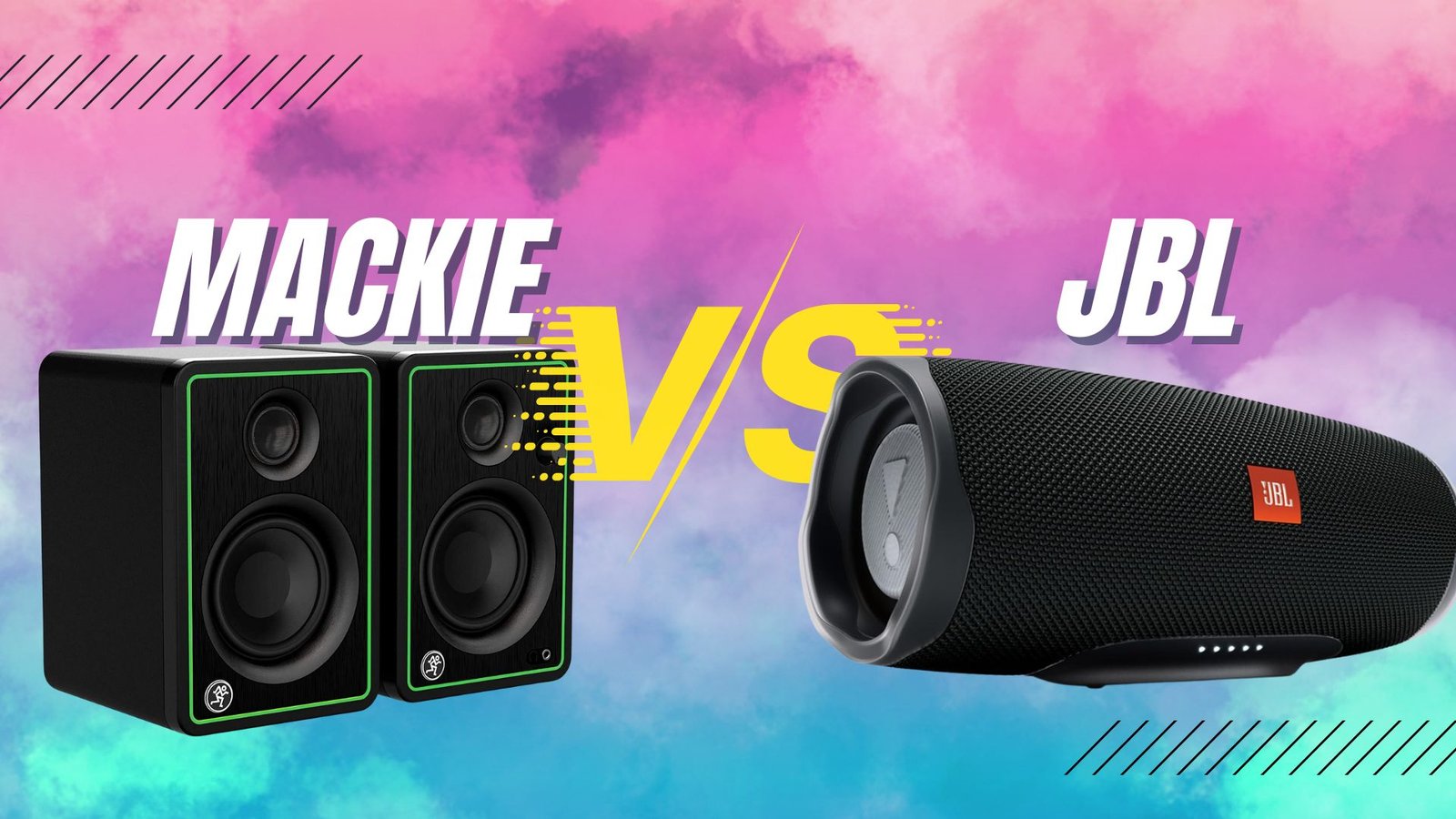In the world of audio equipment, both Mackie and JBL are well-established brands, each catering to a diverse range of professional and personal needs. These brands have carved out reputations for quality, performance, and innovation. Whether you’re a DJ, event coordinator, musician, or audio enthusiast, choosing the right speaker can make all the difference. This post will guide you through the strengths and weaknesses of Mackie vs JBL speakers to help you make an informed decision based on your needs. Mackie vs JBL Speakers.
Table of Contents
Mackie vs JBL Speakers
Introduction
Mackie vs JBL speakers are designed for delivering high-quality audio, serving both the professional and recreational audio markets. Both brands aim to meet the growing demand for portable and powerful speakers that can adapt to various settings, from small gatherings to large-scale performances. Choosing the right speaker is crucial—not just for sound quality, but for reliability, durability, and adaptability to different environments.
This guide compares Mackie and JBL speakers across several key dimensions: product history, features, performance, user experience, pricing, and real-world customer feedback. We’ll also explore which speakers are best suited for specific use cases.
Comparison Table
Detailed Comparison Table between Mackie vs JBL speakers:
| Feature | Mackie | JBL |
|---|---|---|
| Founded | 1988, Woodinville, Washington | 1946, Los Angeles, California |
| Product Lines | Thump, SRM, DRM, C Series, DLM | EON, PRX, PartyBox, Studio Monitors |
| Target Users | DJs, live performers, budget-conscious buyers | Musicians, sound engineers, mobile users |
| Power Output | Thump series: 1300W+ | EON series: 1300W |
| Frequency Response | 40 Hz – 20 kHz (varies by model) | 45 Hz – 20 kHz (varies by model) |
| Bass Performance | Strong, bass-heavy output | Balanced with moderate bass emphasis |
| DSP (Digital Signal Processing) | Yes, customizable DSP profiles | Yes, preset DSP profiles |
| Connectivity | Bluetooth, wired | Bluetooth, wired |
| Build Material | Primarily wood and plastic | Polypropylene, aluminum |
| Design and Portability | Durable but relatively heavy (e.g., Thump 15A) | Lightweight and portable (e.g., EON series) |
| Bluetooth | Available on select models | Available on select models |
| App Control | Limited | JBL app for advanced control |
| Speaker Size Range | 8″ – 15″ woofers | 8″ – 15″ woofers |
| Best Use Cases | Live performance, DJ events, budget setups | Versatile venues, mobile events, vocal clarity |
| Pricing | Lower (Check on Amazon) | Higher (Check on Amazon) |
| Customer Feedback | Praised for affordability and bass, some find bass too strong | Praised for balance and portability, noted higher cost |
| Warranty | Typically 1-2 years, varies by retailer | Typically 1-3 years, varies by retailer |
| Ease of Setup | Generally straightforward with DSP tuning options | User-friendly with app assistance |
| Weather Resistance | Limited models with weather-resistant features | Some models are waterproof (e.g., PartyBox) |
| Sound Signature | Bass-heavy, dynamic for live settings | Balanced, clear, good for vocals and music |
| Overall Value | High value for performance-focused users | High value for balanced, professional-grade sound |
This table provides a side-by-side look at the core features and differences between Mackie and JBL, helping to highlight each brand’s strengths for various use cases.
Pros And Cons
Here’s a pros and cons table comparing Mackie vs JBL speakers, with icons for easy visualization:
| Feature | Mackie | JBL |
|---|---|---|
| Power Output | ✅ High output, ideal for bass-heavy environments like DJ and live shows ❌ Can overpower mids and highs in some models | ✅ Balanced power for clarity across a wide range of sounds ❌ Less bass impact for certain models |
| Sound Quality | ✅ Deep bass performance suitable for electronic and bass-heavy genres ❌ Some models may lack clarity in high frequencies | ✅ Balanced sound signature with clear highs and mids ❌ Not as bass-heavy, may lack impact in large venues |
| Durability | ✅ Sturdy construction for live settings ❌ Heavier design, may be less portable for frequent transport | ✅ Lightweight and durable materials (polypropylene and aluminum) ❌ Less robust feel for rugged use compared to some Mackie models |
| Digital Signal Processing (DSP) | ✅ Customizable DSP profiles for sound tuning based on venue ❌ May require more manual setup than standard profiles | ✅ Preset DSP profiles make it easier to use in different environments ❌ Limited customizability for precise tuning |
| Connectivity | ✅ Bluetooth support on select models ❌ Limited app control for adjusting sound settings | ✅ Bluetooth support with advanced app control on select models ❌ Requires setup through the JBL app for maximum control |
| Portability | ✅ Portable models available, though some are heavy ❌ Heavier weight in some models (e.g., Thump series) | ✅ Highly portable, designed for easy setup and lightweight travel ❌ Plastic construction may not suit rugged conditions |
| Price | ✅ More affordable than many professional models ❌ Budget limitations may affect material quality | ✅ Premium quality with advanced features ❌ Higher price range compared to Mackie models |
| Best Use Cases | ✅ Great for DJs, live music, and budget-conscious users ❌ Less versatile for users needing balanced sound across genres | ✅ Versatile for home, professional, and mobile events ❌ Not ideal for bass-focused setups |
| Customer Feedback | ✅ Positive feedback on affordability and strong bass ❌ Some complaints about overpowered bass | ✅ Highly rated for balance, clarity, and design ❌ Higher cost may limit affordability for some users |
| Setup and Ease of Use | ✅ Simple setup with manual and DSP support ❌ Requires manual tuning to optimize for specific settings | ✅ App support for easy control over sound settings ❌ Learning curve for app users unfamiliar with audio settings |
This table provides a quick visual comparison of the main advantages and disadvantages of Mackie vs JBL speakers, highlighting how each brand meets different user preferences and needs.
Also Read: Beats Studio Buds Plus vs AirPods Pro 2
Product Overviews
Mackie
Mackie was founded in 1988 and quickly became known for producing durable, affordable, and high-quality professional audio equipment. Based in Woodinville, Washington, the company started with a focus on sound mixers before expanding into the world of loudspeakers. Mackie’s speaker lineup includes models designed for portability, power, and clarity, with features tailored to live performances, DJ setups, and audio installations. Notable series include the Thump and SRM lines, both renowned for durability and the ability to produce strong bass and crisp highs.

Mackie speakers often feature built-in DSP (Digital Signal Processing) for better sound control, along with Bluetooth capabilities for ease of connectivity in smaller and mobile setups. They’re especially popular with users who need straightforward, reliable equipment.
JBL
JBL, established in 1946, has a long history of pioneering audio technology. Originally founded by James Bullough Lansing, JBL has become synonymous with high-quality sound across both consumer and professional markets. Acquired by Harman International in 1969, JBL has grown into a global leader in audio, known for cutting-edge innovations and reliable performance. JBL’s speaker portfolio includes a broad spectrum of products, from portable Bluetooth speakers and party speakers to powerful PA systems and studio monitors.

JBL’s speakers, like those in the EON and PRX series, are popular for their versatility, reliability, and modern design, appealing to both home users and professional audio engineers. JBL also uses advanced materials like polypropylene and aluminum in their speaker components, enhancing durability and audio fidelity.
Sound Quality and Reliability
In sound performance, JBL speakers generally produce a well-rounded sound with a focus on clarity and detail, ideal for genres like jazz, pop, and classical music. Mackie speakers, on the other hand, deliver a powerful, bass-heavy sound that works well for electronic music, hip-hop, and other bass-centric genres.
User Experience
Mackie User Experience
Mackie speakers are often praised for their ease of setup and user-friendly design. Many models feature Bluetooth capabilities, making them versatile and compatible with various devices. Mackie’s DSP settings allow users to adjust sound profiles based on the environment, which can be a valuable feature for users in dynamic performance spaces. Mackie’s models are generally durable, although they tend to be on the heavier side, which may be a consideration for mobile performers.
JBL User Experience
JBL speakers are designed with portability in mind. Many models feature easy Bluetooth pairing, and the company’s app enhances user control over sound settings. JBL speakers are built to be rugged yet lightweight, with some models even offering waterproof capabilities, like the PartyBox series. However, JBL’s advanced control options can be a bit challenging for beginners, and some users have noted that certain models require fine-tuning to achieve optimal sound.
Pricing and Value
Pricing is another key difference. Mackie’s Thump and SRM series are generally more affordable than JBL’s EON and PRX series, which can be an advantage for budget-conscious users who don’t want to compromise on performance. JBL’s products, though pricier, come with additional value in terms of design quality, industry-tested reliability, and added features like wireless streaming and advanced DSP controls.
| Model | Average Price | Notable Features |
|---|---|---|
| Mackie Thump | $300 – $500 | Bass-heavy sound, DSP, Bluetooth |
| JBL EON | $500 – $700 | Balanced sound, lightweight, DSP |
Customer Reviews and Testimonials
Mackie Feedback
Mackie’s speakers have received favorable reviews for their durability and sound strength, especially in the bass range. Customers praise models like the Thump for being “affordable without sacrificing quality,” although some users report that Mackie’s sound can be too bass-heavy for certain applications, requiring additional equalization for balanced sound.
JBL Feedback
JBL is widely regarded for the balanced sound and modern design of its speakers. Users of the EON series appreciate the speaker’s “clear and powerful” audio output, noting that the lightweight construction and Bluetooth capabilities make them ideal for frequent transport. Some customers, however, mention that the higher price point is a factor, especially when compared to similar models from Mackie.
Also Read: Sony WF-1000XM5 vs AirPods Pro 2
Best Fit Scenarios
Ideal Users for Mackie
Mackie’s speakers are ideal for DJs, live performers, and users who prioritize bass-heavy audio. The Thump series, for instance, is perfect for small- to medium-sized venues where portability and power are key. Mackie’s speakers also suit users looking for budget-friendly yet durable equipment.
Best scenarios for Mackie:
- DJ performances where bass impact is crucial
- Budget-conscious users needing reliable sound
- Venues requiring durable, high-output speakers
Ideal Users for JBL
JBL’s speakers suit users who value balanced sound and portability. The EON series, with its refined sound profile, fits well in both live music settings and events requiring vocal clarity, such as presentations. JBL is also a strong choice for users who prioritize advanced control over sound settings, making them ideal for professional environments.
Best scenarios for JBL:
- Events where clarity and balanced sound are essential
- Portable setups needing lightweight equipment
- Professional musicians and sound engineers
Conclusion and Recommendation
In the Mackie vs JBL speakers debate, the best choice largely depends on user needs and preferences. Mackie excels in affordability and bass-heavy performance, making it the go-to for DJs and performers who prioritize impact and durability. JBL, with its high-quality build, balanced audio, and advanced control, is better suited for those who need a versatile, high-performance speaker system that’s both portable and reliable.
Recommendation: For DJs and those seeking a budget-friendly, bass-heavy experience, Mackie is an excellent option. For users who prioritize portability, sound clarity, and advanced features, JBL offers an unmatched experience that justifies its higher price point. Ultimately, consider your specific requirements—sound profile, portability, and budget—to determine the best fit.
[Amazon Affiliate Disclaimer: As an Amazon Associate, I earn from qualifying purchases. This means that if you click on an Amazon link on this site and make a purchase, I may receive a small commission at no additional cost to you. This helps support the content on this site and allows me to continue providing valuable information. Thank you for your support!]
Related Keywords:
- mackie vs jbl speakers
- mackie vs jbl powered speakers
- mackie thump vs jbl eon
- mackie thump vs jbl
- mackie thump go vs jbl partybox 310
- jbl vs mackie thump
- mackie thump go vs jbl eon one
- mackie thump go vs jbl eon one compact
- mackie thump go vs jbl partybox
- mackie thump go vs jbl
- is mackie speakers a good brand
- mackie vs bose
- mackie vs qsc speakers
- mackie thump 15a vs jbl eon 615


